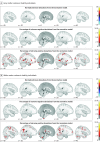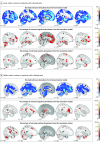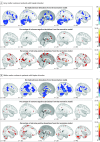Mapping the Heterogeneous Phenotype of Schizophrenia and Bipolar Disorder Using Normative Models
- PMID: 30304337
- PMCID: PMC6248110
- DOI: 10.1001/jamapsychiatry.2018.2467
Mapping the Heterogeneous Phenotype of Schizophrenia and Bipolar Disorder Using Normative Models
Abstract
Importance: Schizophrenia and bipolar disorder are severe and complex brain disorders characterized by substantial clinical and biological heterogeneity. However, case-control studies often ignore such heterogeneity through their focus on the average patient, which may be the core reason for a lack of robust biomarkers indicative of an individual's treatment response and outcome.
Objectives: To investigate the degree to which case-control analyses disguise interindividual differences in brain structure among patients with schizophrenia and bipolar disorder and to map the brain alterations linked to these disorders at the level of individual patients.
Design, setting, and participants: This study used cross-sectional, T1-weighted magnetic resonance imaging data from participants recruited for the Thematically Organized Psychosis study from October 27, 2004, to October 17, 2012. Data were reanalyzed in 2017 and 2018. Patients were recruited from inpatient and outpatient clinics in the Oslo area of Norway, and healthy individuals from the same catchment area were drawn from the national population registry.
Main outcomes and measures: Interindividual differences in brain structure among patients with schizophrenia and bipolar disorder. Voxel-based morphometry maps were computed, which were used for normative modeling to map the range of interindividual differences in brain structure.
Results: This study included 218 patients with schizophrenia spectrum disorders (mean [SD] age, 30 [9.3] years; 126 [57.8%] male), of whom 163 had schizophrenia (mean [SD] age, 31 [8.7] years; 105 [64.4%] male) and 190 had bipolar disorder (mean [SD] age, 34 [11.3] years; 79 [41.6%] male), and 256 healthy individuals (mean [SD] age, 34 [9.5] years; 140 [54.7%] male). At the level of the individual, deviations from the normative model were frequent in both disorders but highly heterogeneous. Overlap of more than 2% among patients was observed in only a few loci, primarily in frontal, temporal, and cerebellar regions. The proportion of alterations was associated with diagnosis and cognitive and clinical characteristics within clinical groups. Patients with schizophrenia, on average, had significantly reduced gray matter in frontal regions, cerebellum, and temporal cortex. In patients with bipolar disorder, mean deviations were primarily present in cerebellar regions.
Conclusions and relevance: This study found that group-level differences disguised biological heterogeneity and interindividual differences among patients with the same diagnosis. This finding suggests that the idea of the average patient is a noninformative construct in psychiatry that falls apart when mapping abnormalities at the level of the individual patient. This study presents a workable route toward precision medicine in psychiatry.
Conflict of interest statement
Figures





Comment in
-
Using Brain-Based Phenotyping to Improve Discovery in Psychiatry.JAMA Psychiatry. 2018 Nov 1;75(11):1103-1104. doi: 10.1001/jamapsychiatry.2018.2451. JAMA Psychiatry. 2018. PMID: 30304331 Free PMC article. No abstract available.

